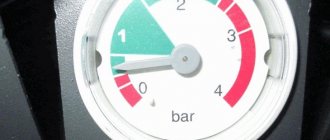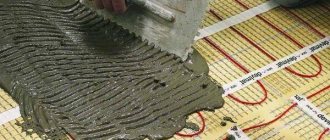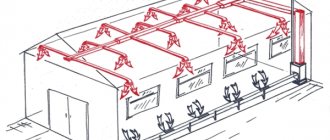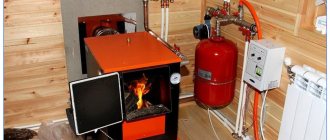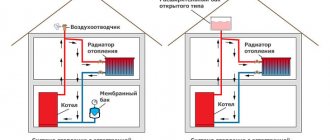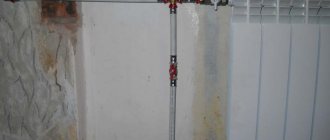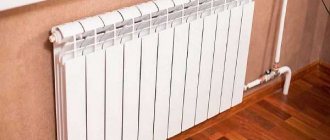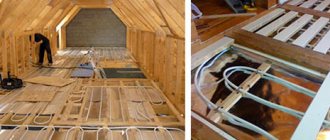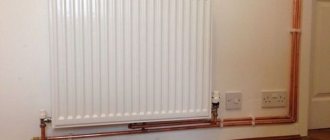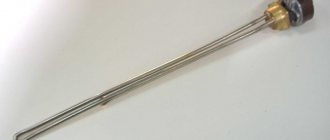When installing a heating system ourselves, among other issues, we need to decide at what distance from the wall to hang the radiator. Although this aspect may not seem important enough to some, in fact, the efficiency of the system largely depends on compliance with the installation parameters.
In our article we will tell you why it is necessary to monitor the distance from the battery to surfaces, and also provide recommendations for installing a radiator on a wall or floor.
Installing the battery close to each other is not a good idea!
Step-by-step installation algorithm
Silicone tape promotes better sealing of connections
After calculating all the necessary values and choosing a connection method, you can proceed to installing radiators. All work must be carried out in accordance with the requirements of SNiP. You must also follow the manufacturer's instructions. If the instructions are violated, there is a risk of loss of warranty service. According to regulations, you do not have to remove the protective film from the devices during installation. This way the device will be protected from dust and scratches during installation work.
Items required for connection:
- Hooks with plastic dowels - at least 3 pieces. Needed for mounting to a wall or floor.
- 2 side plugs with right-hand thread. They are designated D.
- 2 plugs with left-hand thread with the letter S.
- Stub.
- Silicone sealing thread or flax.
- The elements required by the scheme are taps, valves, valves.
- Pipes. Metal or polypropylene are selected. Metal products are distinguished by high quality, durability and long service life. Polypropylene pipes are cheaper.
Tools you will need:
- Electric drill and drill bit. Selected according to the hardness of the wall.
- Screwdriver.
- Building level.
- Key.
- Tape measure and a simple pencil.
Depending on the design of the radiator, an air vent is selected.
The general installation procedure for various parts of the heating system is also regulated by SNiP.
- Making markings for brackets. This is done using dowels or cement mortar. There must be at least three brackets in total.
- Installation of plugs, adapters, Mayevsky taps and other parts.
- Installation of the radiator itself. It is necessary to connect its pipes to the heating system.
- Installation of an air vent. It should be automatic.
- Removing the protective film.
If these requirements are met, the installation of the system will be of high quality and durable.
Wall mount
Wall mounting material
Wall mounting is easier to make than floor mounting.
Installation is carried out as follows:
- Preparing the mounting site. First, the heating circuit pipe is connected. The wall behind the radiator needs to be covered with foil material.
- Preliminary marking of the mounting location for the clamps.
- Installation of fasteners using dowels. The depth into the wall must be at least 6 cm to securely fix the battery.
- Mounting the radiator onto the brackets. Fixing and leveling the device.
- Connection to pipes. Checking the tightness of all connections.
- Test run of the system.
During installation, it is important to make horizontal alignment of the battery. Otherwise, air will accumulate in the device, which reduces the heating intensity and leads to corrosion.
It is also important to comply with the location of the battery. It must be installed strictly in the center of the window
Fastening elements are different. They can be made in the form of suspensions, brackets and other structures. Regardless of the type, they have the same task - securely fixing the radiator to the wall. Instructions for attaching the clamps are included along with the elements themselves.
Floor mount
Floor mounting for large, heavy radiators or thin walls
Heavy and massive radiators cannot always be hung on the wall. Not every fastener can withstand such a load, so they use a floor installation method. For this, special brackets are used. They are more expensive, but their mounting reliability is higher than that of wall-mounted models.
Stages of floor-mounted radiator installation:
- Selection of brackets that are designed to support the weight of the battery.
- Installation on the base area allocated for the radiator. Fixation is carried out using anchor bolts at a distance of at least 6 cm from the wall. The height of the radiator from the floor must be maintained.
- Carrying out concrete work. Filling the base of the brackets and bolt heads with screed.
- Putting hooks on the racks. They are adjusted to the desired height and secured with bolts. If provided by the package, protective metal gaskets are installed.
- Installation on hooks at the pre-calculated height of the battery from the floor. The radiator, as in the case of wall mounting, must be aligned horizontally.
The floor system has an important advantage. All the weight from the battery falls on the floor and is not distributed along the wall
By moving away from the floor, a gap will be created that allows air to circulate. Typically, this scheme is used for heavy cast iron heating radiators, but aluminum or bimetallic devices can also be mounted using the floor method.
Rules and installation procedure
As a rule, a heating device is installed under the window, since the rising heated air cuts off the cold coming from the opening. To prevent glass fogging, the width of the radiator must be chosen to be 70–75% of the width of the window.
Basic installation rules
SNiP recommends the following rules for installing heating radiators to indentations:
- The heating radiator is installed exactly in the middle of the window opening. Before installation, the width is divided by two, then the distances to the points of location of fasteners are set aside on the right and left sides.
- The radiator should retreat from the floor level to a height of 8–14 cm. A smaller interval will lead to difficulties during cleaning, and a larger interval will lead to the formation of zones of unheated air.
- Radiators should be hung at a distance of 10–12 cm from the windowsill. If you place the device closer, convection will worsen and heat transfer will decrease.
- The distance from the wall to the radiator should be about 3–5 cm; this is the gap size that can ensure unhindered heat distribution and normal convection. If the location is too close to the walls, dust will accumulate on the back surface of the batteries, which is quite difficult to remove.
Taking into account the requirements of SNiP, it is possible to determine the optimal length of the battery and select a model that corresponds to specific conditions.
The above rules are the same for all types of radiators. Individual manufacturers set their own standards, which must be followed. Therefore, before purchasing, it is necessary to study the installation requirements and make sure that they can be met in specific conditions.
Work order
Installing a heating radiator with your own hands requires careful attention to each stage of work, taking into account every detail. To hang sections, experts recommend using three attachment points: two upper and one lower.
Any sectional battery is hung on holders through the upper collector. Thus, the mount located at the top bears the main load, and the holder located at the bottom serves as a guide and fixing element.
Connection methods
SNiP prescribes the basic rules for installing heating radiators
The ability of the radiator to withstand pressure is important. The manufacturing material should not react with the pipes that are connected to the product in order to avoid corrosion processes
The battery should be placed 10 centimeters below the protruding part of the window sill to release heat flow.
The distance between the floor and the bottom of the radiator should be more than 10 and less than 15 centimeters. This is a fundamental issue, otherwise the processes of uniform heat transfer will be disrupted. All sections must be connected evenly and have no significant differences in height.
In order for heat transfer to occur most efficiently, it is important to place the heating radiator correctly. Experts recommend placing it under the windows to minimize heat loss through these areas.
If there is an external cold wall, it is recommended to place additional devices on it.
In general, batteries in an apartment can be located in several ways:
- lateral location;
- lower;
- diagonal;
- sequential.
The most popular is the side arrangement of batteries. It is characterized by high heat transfer. The pipe through which hot water flows is inserted into the upper pipe, and the outlet comes from the lower one. In the case of bottom placement, both pipes are located at the bottom. The diagram is relevant if the pipes are located in the floor or under the baseboard.
Diagonal is used when the battery has a large number of sections, 12 or more. The coolant enters through the top pipe and exits from the bottom. Consistent is relevant when the plumbing system has sufficient pressure so that hot water passes through all radiators.
In cases where it is necessary to install an additional radiator, the coolant must first be removed from the system. After securing the brackets, the radiator is attached, the connections are secured with a special key. You need to install a Mayevsky tap on the free hole, and close all the others with a plug. Next, you should attach the battery itself and carefully align it. After this, the remaining elements are brought in and everything is connected into a single system, which must be absolutely sealed.
Necessary theory
There are two types of heating systems that are most widely used these days:
- single-pipe;
- two-pipe.
A special feature of single-pipe systems is the supply of coolant to the house from top to bottom. This scheme is used in most standard apartment buildings. The disadvantage of the system is the inability to control the temperature regime in the home without installing additional equipment. With this heating method, the water in the radiators on the upper floors will be significantly warmer than on those located below.
Heating system installation
With two-pipe heating, the heated coolant is supplied through one pipe, and the water that has given up its heat circulates through the second (return) pipe. This heating system is used in cottages and private houses. The advantage of two-pipe systems is the relative constancy of the temperature of the batteries and the ability to regulate the heating mode.
Radiator installation diagrams
The differences in installation schemes lie in the way they are connected to a private or centralized network.
The most common schemes are the following:
- Lateral connection. Allows you to achieve the greatest heat transfer. The supply pipe is connected to the pipe located at the top, and the return pipe to the bottom. When connected in reverse (water supply from below), the power of the system is reduced.
- The connection is diagonal. Optimal for batteries of considerable length, characterized by minimal heat loss. In this case, the radiators are heated evenly. The inlet pipe is connected to one side of the upper pipe, and the outlet pipe is connected to the reverse side of the bottom pipe.
- The lower connection (“Leningradka”) is used for hidden pipe laying.
Options for connection diagrams
Installation of heating devices according to this scheme, characterized by significant heat loss, is used when laying heating pipes in the area of the lower ceiling.
How to place batteries
First of all, recommendations concern the installation location. Most often, heating devices are installed where heat loss is the most significant. And first of all these are windows. Even with modern energy-saving double-glazed windows, it is in these places that the most heat is lost. What can we say about old wooden frames?
If there is no radiator under the window, then the cold air descends along the wall and spreads along the floor. The situation is changed by installing a battery: warm air, rising upward, prevents cold air from “draining” onto the floor. It must be remembered that in order for such protection to be effective, the radiator must occupy at least 70% of the width of the window. This norm is prescribed in SNiP. Therefore, when choosing radiators, keep in mind that a small radiator under the window will not provide the required level of comfort. In this case, there will be zones on the sides where the cold air will go down, and there will be cold zones on the floor. In this case, the window may often “sweat”, condensation will form on the walls in the place where warm and cold air collide, and dampness will appear.
For this reason, do not try to find the model with the highest heat output. This is justified only for regions with a very harsh climate. But in the north, even the most powerful sections have large radiators. For central Russia, average heat transfer is required, for southern regions, low radiators are generally needed (with a small center distance). This is the only way you can fulfill the key rule for installing batteries: blocking most of the window opening.
In cold climates, it makes sense to install a thermal curtain near the front door. This is the second problem area, but it is more typical for private houses. This problem may occur in ground floor apartments. The rules here are simple: you need to place the radiator as close to the door as possible. Choose a location depending on the layout, also taking into account the possibilities of piping.
What is needed for installation
To secure heating devices, you will need to purchase various materials and additional devices. Their set is almost identical, but for cast iron batteries, for example, larger diameter plugs will be required, and the installation of an air vent instead of a Mayevsky tap.
The installation of bimetallic and aluminum batteries is absolutely the same.
When choosing a radiator, you should take into account that many manufacturers provide a warranty on devices only when installed by organizations that have the appropriate license.
Required tools and materials
When installing radiators with your own hands, you will definitely need to use brackets or holders. Their number is determined depending on the size of the radiators:
- if you plan to install the device in no more than eight sections or up to 1.2 m in length, two points will be enough for reliable fastening - above and below;
- Every subsequent 5-6 sections or 50 cm of battery length requires adding another pair of fasteners.
Distance from the floor for the office and kitchen
A wider window sill will allow the surface to be used for utilitarian purposes
In such rooms, the placement of the window sill largely depends on the arrangement of the furniture. In offices, the main natural lighting of the workspace is important, so the dimensions should be selected to ensure this condition.
Some people specifically make wide window sills and use them as a desk. On average, the distance from the floor should be about 60-65 cm. These are the optimal dimensions; they will illuminate most of the office.
In the kitchen, the window sill is often combined with furniture, increasing the usable area
In the kitchen, the window sill is often located at a distance of 90 cm from the floor. Most of the kitchen furniture has the same height. With such dimensions, if you place the dining table in the center, it will be fully illuminated.
If you plan to install a bar counter, the height will need to be increased. Under such circumstances, it should be about 120 cm from the floor.
The choice of placement in the corridor is not so critical, because no one stays there for a long time. A landing at 80 cm is considered optimal.
Requirements for installing heating radiators
Create an account
Register in our community. It's very simple!
Already have an account? Sign in.
Or login using one of these services
Google recommends
Our recommendations
Table made of slabs. Swallows Hoffmann
Sano published a blog post in Slab Furniture, Sunday at 20:28, blog post
I make a table to order, the tabletop is made from slabs of elm or otherwise elm.
In one of the slabs there is a fairly extensive and sometimes through crack. I cleaned it and also filled it with epoxy resin, it will seal the crack and also level the surface of the countertop.
As an additional blocking from the opening of the crack, Hoffman swallows are embedded, which not only enhance, but also create a decorative effect.
Some will say that they spoil the appearance, and they should have been placed on the back side of the countertop. But the fact of the matter is that you can’t put them there because of the features of the countertop.
I personally like these swallows and besides, their presence was approved by the customer of the table.
They were made from scraps of the same tabletop, two dark swallows lay on the light half, and one light one was cut into the dark half of the tabletop.
A short excursion into where this furniture element came from. For me, this Homphan did not invent anything, but simply took what has been used for centuries in carpentry and other art. In fact, this is the same dovetail connection.
Let's leave this to the author's conscience; besides, the name swallow or Hofmann's butterfly stuck to this type of connection, just as, for example, all copying machines are called Xerox.
In 1985, while still a student at Harvard University, Thomas Hoffmann developed a system for joining parts made of wood and chipboard materials (MDF and chipboard), which was named “Hoffmann Swallow” and was soon adopted throughout the woodworking industry.
Ceilings yin and yang
Ramon published a topic in Our works, December 12, 2008, topic
One of our first works supported the oriental theme with a sakura branch
birch suvel
Sano published a blog post in Slab Furniture, January 23, blog post
This is the cut of birch we brought to the workshop, while we are preliminary planning to make a coffee table.
The preparation of such material itself was not the easiest thing, not only was it found in the forest, it was also difficult to remove, then the suvel was cut into pieces, but after that it was cooked using a special technology for a couple of weeks, and then dried for a couple of years.
In general, this is a whole epic, and due to the fact that so much has been done just for the blank and based on the size, the price of such material is already becoming very high. And this is not the table itself.
You need to approach the work thoughtfully and make a smooth tabletop with minimal loss in the thickness of the workpiece.
What is it for?
Phoenix posted a topic in Tools and Equipment, January 15, topic
I suggest warming up for those who are interested.
Does anyone have any guesses as to what this is for?)
#4 Do not install a jumper
Unscrupulous plumbers take advantage of clients’ ignorance and make their work easier, for example, by not installing a bypass jumper on the heating device. It is necessary to be able to shut off the battery without turning off the neighbors’ heat. In addition, if one of the other residents wants to reduce the temperature in the apartment, this will not affect those who have a jumper. However, if there is no tap on the device, then a bypass is not needed.
Features of installing radiators in an apartment
The given rules for installing heating radiators are general for both individual systems and centralized ones. But before installing new radiators, you must obtain permission from the management or operational company. The heating system is common property and all unauthorized alterations have consequences - administrative fines. The fact is that with a massive change in the parameters of the heating network (replacing pipes, radiators, installing thermostats, etc.), the system becomes unbalanced. This can lead to the entire riser (entrance) freezing in winter. Therefore, all changes require approval.
Types of wiring and connections of radiators in apartments (click on the picture to enlarge its size)
Another feature is of a technical nature. If it is vertical (one pipe enters through the ceiling, goes to the radiator, then comes out and goes to the floor), when installing the radiator, install a bypass - a jumper between the supply and discharge pipelines. Paired with ball valves, this will give you the opportunity to turn off the radiator if desired (or in an emergency). In this case, no approval or permission from the manager is required: you have turned off your radiator, but the coolant continues to circulate through the riser through the bypass (that same jumper). You don't need to stop the system, pay for it, or listen to your neighbors' complaints.
A bypass is also needed when installing a radiator with a regulator in an apartment (the installation of the regulator also needs to be coordinated - it greatly changes the hydraulic resistance of the system). The peculiarity of its operation is that it blocks the flow of coolant. If there is no jumper, the entire riser is blocked. Can you imagine the consequences...
Battery Installation Standards
Organization of heating is necessary in any country house, and each stage of this work must be carried out in compliance with all technical requirements. Therefore, the correct installation of heating radiators is very important; failure to comply with fundamental requirements will lead to a violation of the technology and reduce the efficiency of the system.
When installing heating radiators in Moscow and other regions, you need to remember not only the correct method of connecting devices, but also the correct selection of the type of heating equipment.
Heating battery installation diagrams
Before you begin installation, you need to decide on the connection diagram. There are the following options for installing heating radiators:
- Lateral connection is the most popular today, since with its help you can achieve the greatest heat transfer. In this case, the inlet line is connected to the upper branch pipe, and the outlet pipe to the lower one. If this rule for installing heating batteries is not followed, the power, and with it the efficiency, of the system will decrease.
- The diagonal connection is great for long radiators, as it will allow the battery to be heated evenly. In this case, on one side, the inlet pipe is connected to the upper pipe, and on the other side, the outlet pipe is connected to the lower one. When supplying coolant through the lower pipe, the power is reduced by 10%.
- The lower connection diagram is used if the heating system runs under the floor. Compared to a side connection, this method reduces heat transfer by 5-15%.
Installing radiators: instructions
After choosing the type of connection, you can begin installing the batteries, taking into account the recommendations of SNIP
In addition, when installing heating radiators, the instructions supplied by the manufacturer should also be taken into account, since if the rules for installing heating radiators are not followed, the right to warranty service will be lost, and you will have to solve problems yourself
According to the installation standards for heating radiators, installation is possible without removing the protective film, this way you will protect the devices from dirt and dust, as well as from scratches during installation. Installation of SNiP heating radiators requires compliance with the following indentations.
- According to the standards for installing a battery, a distance of 100 mm is required from the bottom of a niche or window sill; if the distance is less than ¾ of the depth of the battery, the heat flow will be less and it will be difficult for heated air to enter the room.
- The installation height of heating radiators should be 120 mm from the floor to the bottom of the radiator; if the offset is less than 100 mm, then heat exchange will be difficult, and cleaning the floor in this area will also cause difficulties. If the offset exceeds 150 mm, the temperature difference in height will be greatly increased, this will be especially noticeable in the upper part of the room.
- Correct installation of heating radiators requires a distance from the wall plane of at least 20 mm. When installing the battery close to the wall or with a gap of less than 20 mm, heat transfer will deteriorate, and a dust trail will appear on the top of the radiator.
Installation of heating radiators, photos, videos will help you not to make mistakes during the installation process and organize a reliable and efficient heating system in your home.
SNiP also regulates the procedure for installing heating devices.
- First, the space for the brackets (at least 3) is marked.
- Next, the brackets are strengthened using cement mortar or dowels.
- Installation of Mayevsky tap, plugs, adapters, etc.
- Then they begin to install radiators.
- Next, connect the batteries to the pipes of the heating system.
- After this, an air vent is installed; according to SNiP, it must be automatic.
- Lastly, the radiators are freed from the protective film.
If you follow these rules, radiators will provide warmth in the room during the cold season and will last a long time.
Distance from window sill to radiator
Almost all modern radiators and sectional heating radiators amaze with their high efficiency and efficiency, providing such indicators due to air convection and its natural flow through the heat exchange system. It is precisely because of these design features that it is not enough just to buy highly efficient radiators and power them with coolant; it is necessary to provide conditions for convection - the natural transfer of heat by air. Let us indicate the required distance from the window sill to the radiator, as well as the main installation recommendations, as conditions for maintaining high efficiency.
Window sill board.
When installing marble window sills in an apartment or private house, many focus only on the upper gap of 100 mm, completely forgetting that by choosing an overly protruding, wide window sill, you can disrupt not only the thermal cutoff of cold air, but also change the overall air circulation along the windows. The window sill board should not block the radiator, creating a kind of niche for the battery, suggesting an enveloping movement of heat along it. Unfortunately, a specific size cannot be recommended, and the protrusion of the board should minimally interfere with air convection near the radiator and move it away from the glass.
Radiator mounting.
Before drawing the first mounting point on the wall, carefully study the included instructions for the radiator, as... Most manufacturers inform about the recommended installation gaps that ensure high heat transfer of this particular battery. In the absence of such recommendations, they use general ones, according to SNiP 3.05.01-85. "Internal sanitary systems":
The minimum distance from the bottom of the window sill to the radiator is 100mm, since reducing it reduces the heat flow of air. From the floor to the bottom of the radiator, the gap is in the range of 100-150mm, and increasing the distance increases the temperature difference in the entire room, and decreasing it again reduces the intensity of heat transfer
It is also important to take into account the distance from the wall to the radiator; it is made 25-30mm, because the rear surface is also actively involved in heat transfer
If the factory recommendations differ from SNiP, they are guided by the manufacturer who developed the battery.
The efficiency of its operation and the comfortable temperature in the room depend on the correct installation of the heating device. For the efficient operation of the heating system, it is important not only the correctness of its assembly, the quality of the equipment and the tightness of the connections, but also compliance with the standardized distances from the heating devices to the surrounding structures (floor, walls, window sill)
It is especially important to maintain the distance from the battery to the window sill, because obstacles from above can interfere with the normal circulation of convection currents. We will list the standards for installing heating radiators in apartments and private houses
Today you can find radiators on sale in different designs and from different materials.
They are also divided according to installation methods and come in the following types:
- Floor-standing devices have special legs for installation on the floor in the room. In any case, such radiators are installed at some distance from the wall surface and the protruding horizontal structures of the window opening.
- Wall-mounted radiators are mounted on supporting brackets fixed to the walls of the room. They are usually installed under window openings so that rising convection currents create a thermal curtain in front of the window, because it is through the glazing that the room loses the most heat.
In any case, when installing a heating device, you must follow the rules for installing batteries. It is easiest to maintain the required distance from the wall to the unit when hanging on walls, because in this case special brackets are used, which, due to their configuration, provide the required clearance. When installing a floor-standing device, the distance will have to be adjusted manually.
conclusions
It is always necessary to maintain the correct distance from the wall to the heating radiator, regardless of the design of the product, its shape or other operational characteristics.
It does not matter what kind of heating system in a house or apartment: single-pipe or two-pipe, central or autonomous heating. In any case, space is needed for heat exchange between the air and the radiator.
If this rule is not followed, the energy efficiency of the heating system will be significantly reduced and the radiators will have a shorter service life. As a result, costs for energy resources, repairs or replacement of heating system components will increase.
Source
Primary requirements
The distance from the floor to the window sill may vary depending on the type of window. However, GOST provides for the permissible coefficient at which heat is best retained in the room, and the figure is 0.55 W/°C×m². This means that in order to achieve the desired effect, you need to use a plate that will have low thermal conductivity.
The distance of the radiator to the window sill plays an important role: in this case, there is SNiP, the main provisions of which require:
The window sill should have a slight slope into the room - at least 1˚. There must be thermal insulation between the wall and the structure. During installation, the height from the floor is taken into account. All window sills must be at the same level. The length of the window sill should not be more than 3 meters. The length is set relative to the window opening, with a difference of 4 mm. The distance required to retreat from the battery to the window sill should not be less than 8 cm. It is recommended to saw off the excess parts at room temperature.
Types of heating systems
There are three options for radiator connection systems - serial, single-pipe, two-pipe and collector (parallel). They differ in the wiring diagram. Depending on what system is installed, it is necessary to select the type of batteries. It is important to remember that incorrect connection of heating radiators leads to a decrease in the actual thermal power of the batteries.
Serial connection
This is the simplest option for connecting radiators. From the heating device the pipe passes to the first radiator, from it to the second, etc. This connection option has become obsolete, since the water cools quickly and the heating level drops sharply with distance. There is no option to turn off an individual battery - you have to shut off the entire system.
A clear example of serial connection of radiators.
Single pipe system
A single-pipe system uses one main pipe through which heated water or other coolant flows from a heating device (heat pump, boiler, boiler, etc.). Each battery is connected in such a way that the liquid passing through it returns to the main line.
The radiator can be turned off using a valve or shut-off valve without shutting off the main pipe. The water temperature in each subsequent radiator drops, but not as significantly as with a series connection.
Two-pipe system
The supply of heated water and the discharge of cooled water in the system occurs through different mains. Each radiator is connected to both pipes. In such a system, the temperature of the liquid at the inlet of each radiator is almost the same; it decreases slightly due to heat loss in the pipes.
Collector (parallel) system
In this system, all batteries are connected in parallel. One line comes out of the heating device, which is connected to the collector (popularly called a comb). In the collector, water is distributed through several pipes, each of which leads to a separate radiator. The shut-off valves are located on the manifold.
Collector or parallel heating system
The collector system can work in conjunction with any other. For example, several radiators connected to each other in parallel using a single-pipe or two-pipe system can be connected to the main line with warm water leaving the collector. The number of heating radiator sections depends on the selected system and type of connection. You can calculate them using an online calculator.
Amendments to calculations and advice
The methods discussed above for calculating the number of radiator sections are perfect for rooms whose height reaches 3 meters. If this figure is greater, it is necessary to increase the thermal power in direct proportion to the increase in height.
If the entire house is equipped with modern plastic windows, in which the heat loss coefficient is as low as possible, it becomes possible to save money and reduce the result by up to 20%.
It is believed that the standard temperature of the coolant circulating through the heating system is 70 degrees. If it is below this value, it is necessary to increase the result by 15% for every 10 degrees. If it is higher, on the contrary, reduce it.
Premises with an area of more than 25 square meters. m. heating with one radiator, even consisting of two dozen sections, will be extremely problematic. To solve this problem, it is necessary to divide the calculated number of sections into two equal parts and install two batteries. In this case, the heat will spread throughout the room more evenly.
If there are two window openings in the room, heating radiators should be placed under each of them. They must be 1.7 times more powerful than the rated power determined in the calculations.
Having purchased stamped radiators where sections cannot be divided, it is necessary to take into account the total power of the product. If it is not enough, you should consider buying a second battery of the same type or one with a slightly lower heat capacity.
Many factors can influence the final result. Let's consider in what situations it is necessary to make correction factors:
- Windows with regular glazing – magnifying factor 1.27
- Insufficient thermal insulation of walls - increasing factor 1.27
- More than two window openings per room – magnifying factor 1.75
- Manifolds with bottom wiring – magnifying factor 1.2
- Reserve in case of unforeseen situations – increasing factor 1.2
- Use of improved thermal insulation materials – reduction factor 0.85
- Installation of high-quality thermal insulating double-glazed windows – reduction factor 0.85
The number of amendments made to the calculation can be huge and depends on each specific situation. However, it should be remembered that it is much easier to reduce the heat output of a heating radiator than to increase it. Therefore, all roundings are made upward.
If you need to make the most accurate calculation of the number of radiator sections in a complex room, do not be afraid to turn to specialists. The most accurate methods, which are described in specialized literature, take into account not only the volume or area of the room, but also the temperature outside and inside, the thermal conductivity of the various materials from which the frame of the house is built, and many other factors.
Of course, you can not be afraid and add several edges to the result. But an excessive increase in all indicators can lead to unjustified expenses, which are not immediately, sometimes and not always, able to be recouped.
#5 Choose a manufacturer at random
Apartment owners devote most of their efforts to searching for a high-quality radiator, but do not worry about component manufacturers. You should opt for more expensive parts.
For installation you will need:
- 1-2 taps for connecting to the heating system;
- coupling for connecting two sections of pipeline;
- 2-4 through plugs;
- stub;
- air vent;
- brackets.
When choosing parts, you need to pay attention to the smallest nuances: the number of turns on the thread, the quality of plastic and brass, the presence or absence of a retaining ring. The collapsible connection differs from more expensive manufacturers by a paronite gasket with a large contact area and a thick brass nut.
The importance of the gap between the wall and the battery
The minimum distance between the wall and the radiator is 25 mm; no thermal insulation layer is laid on the wall.
When installing radiators, it is important to create a distance between the heating device and the wall. The outer wall is constantly in contact with the surrounding air, causing significant cooling
When the battery is mounted on the inner surface without a gap, most of the heat will be spent on heating the wall material rather than the room. The low thermal insulation properties of concrete walls do not allow creating an optimal microclimate; about 70% of thermal energy will be wasted. By moving the heating system a short distance, air insulation will be created, increasing heating efficiency.
There are other reasons why it is necessary to create a gap according to the given standards:
- Creating a sufficient level of air mass circulation. If this condition is violated, part of the energy will be lost.
- When placed close to the wall, the device begins to heat up faster. As a result, the radiator may fail.
- Dust and debris will accumulate between the wall and the battery, which also impede heat transfer.
- In the absence of a heat-reflecting plate, the radiator will waste heat on the external walls.
- If an electric battery is installed, there is a risk of short circuit. Hydronic heating systems can be susceptible to corrosion if there is no clearance.
When installing heating devices, you must adhere to the following recommendations - the greater the radiator power, the wider the gap should be. Its specific dimensions are made up of two important parameters:
- Window sill width, niche dimensions. The possibility of creating distance depends on these individual characteristics.
- The power of the battery itself.
Radiator selection
There is a wide range of radiators on the market today, designed for different buyers. The principle “the more expensive the better” does not always work here. You need to make your choice based on the following reasons:
- place of residence;
- heating system wiring;
- on how the heating radiators will need to be installed;
- temperature conditions in the heating system;
- accounting for what material was used in the production of pipes;
- the need for control elements and fittings;
- location of the premises in the building.
Having completed this analysis, you can proceed to choosing a battery.
Today, cast iron radiators can look quite presentable; they can be decorated. Thus, they can easily fit into the overall design of the room.
Cast iron radiators of the modern type are no longer the huge accordions that were in the Soviet apartment, but flat panels with smoothed corners and a presentable appearance. Having good physical heating properties, cast iron retains heat for a long time and gradually releases it into the room. Such radiators have a long service life, 20-50 years. The main disadvantage is their large weight (one section weighs about 8 kg), so it is impossible to install them correctly in rooms where the walls are made of wood or plasterboard. Having a rough surface, they are not very easy to clean.
Aluminum radiators differ little in design from cast iron ones; the only difference is the weight of the sections (1 kg). Also, such devices have good heat transfer properties, a smooth surface, ventilation windows evenly distribute air in the room, and they can be attached to any surface. The main disadvantage is the easy perception of the chemical composition of water and pressure surges in the pipeline.
Bimetallic radiators are a compromise solution between cast iron and aluminum. Externally they are almost no different from aluminum ones, but are not sensitive to the composition of water and pressure surges. They have good heat transfer performance, are easy to install and are inexpensive.
Steel radiators have a panel appearance and a relief surface. They have various connection options and good thermal properties. No major deficiencies were identified.
